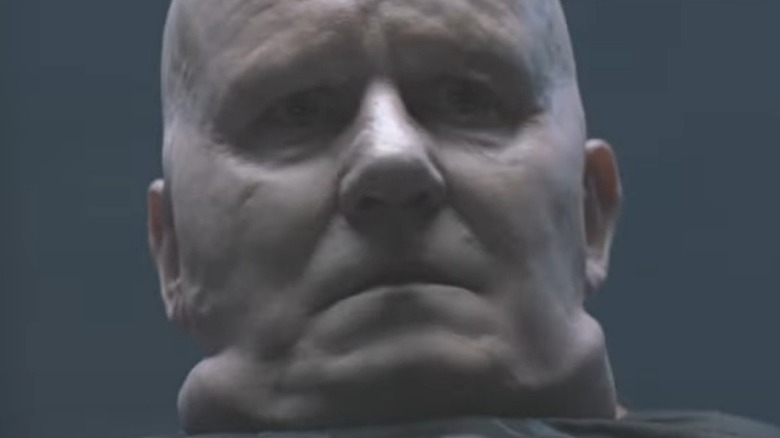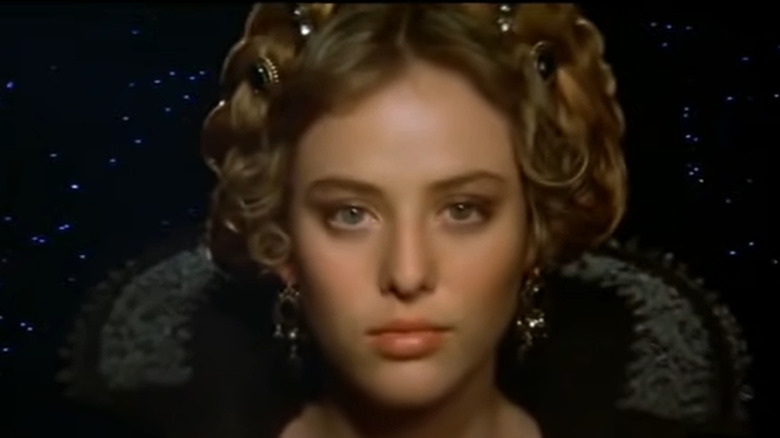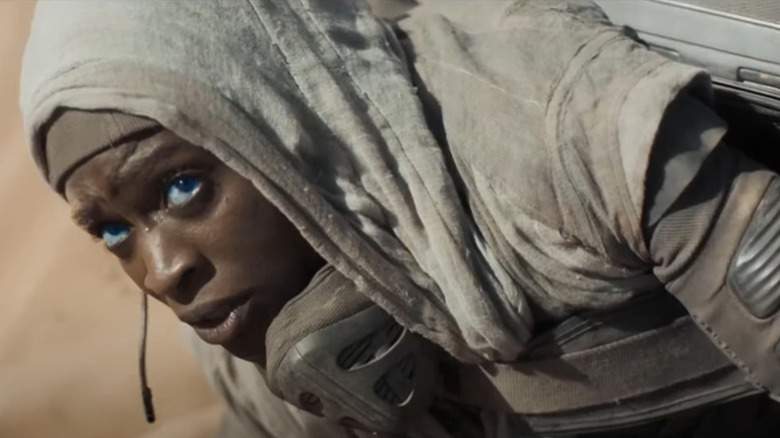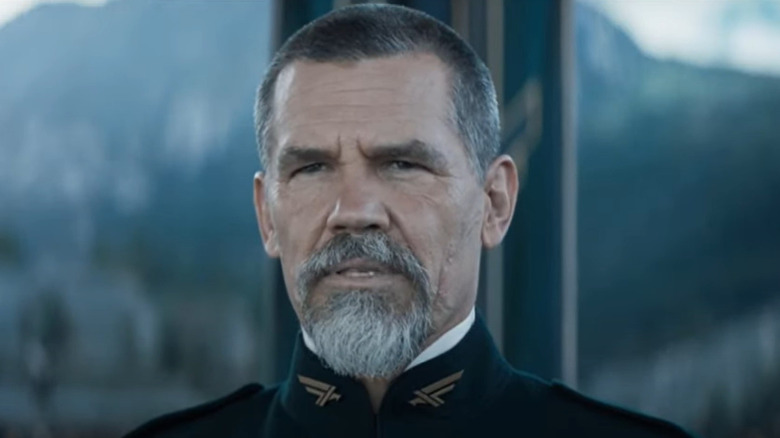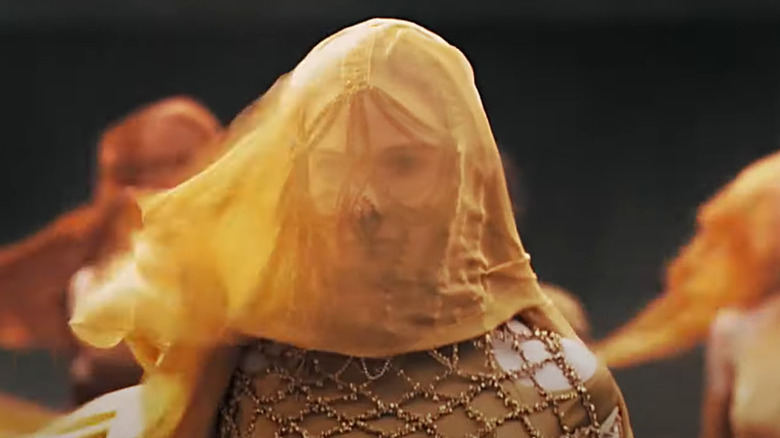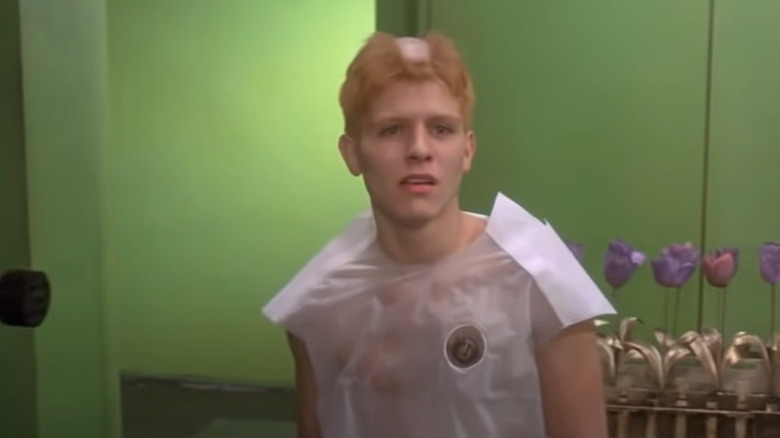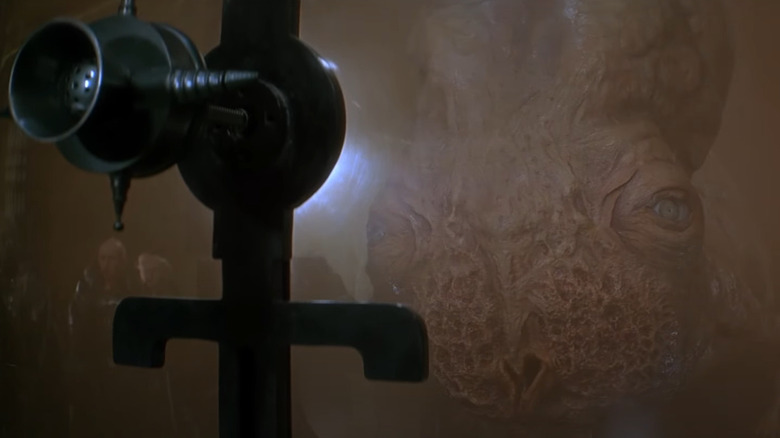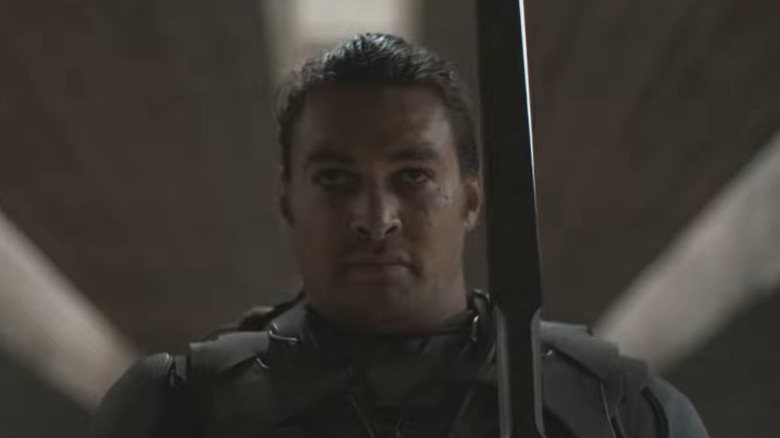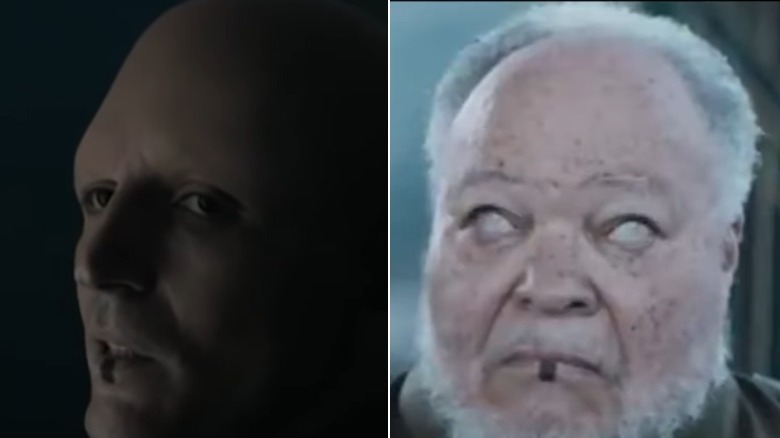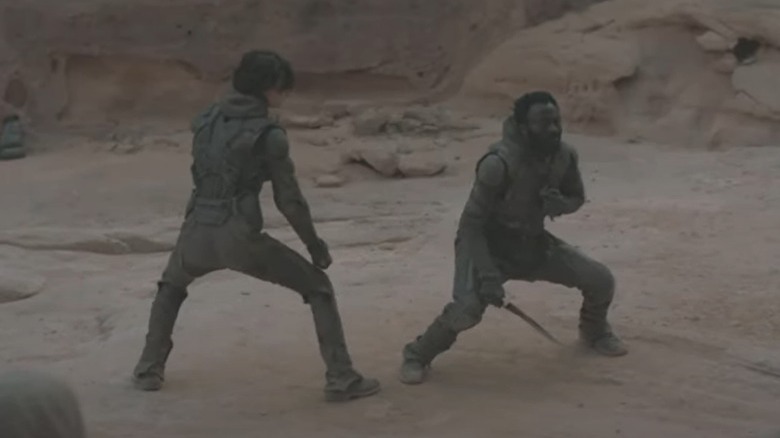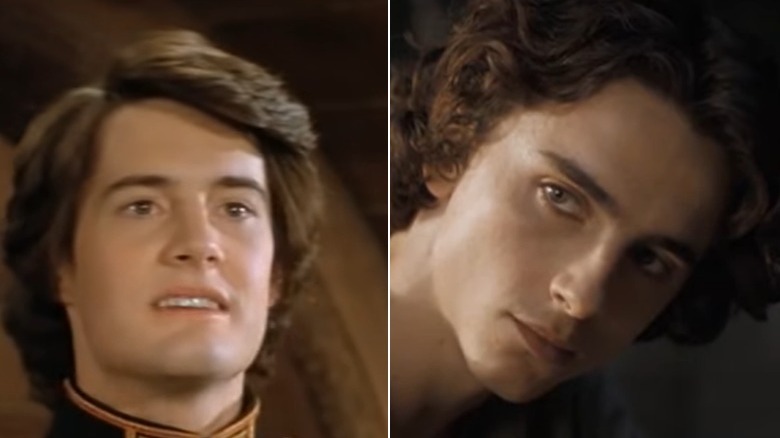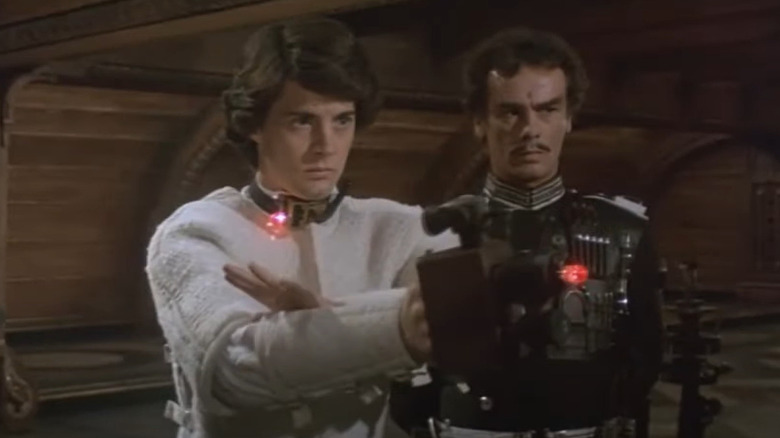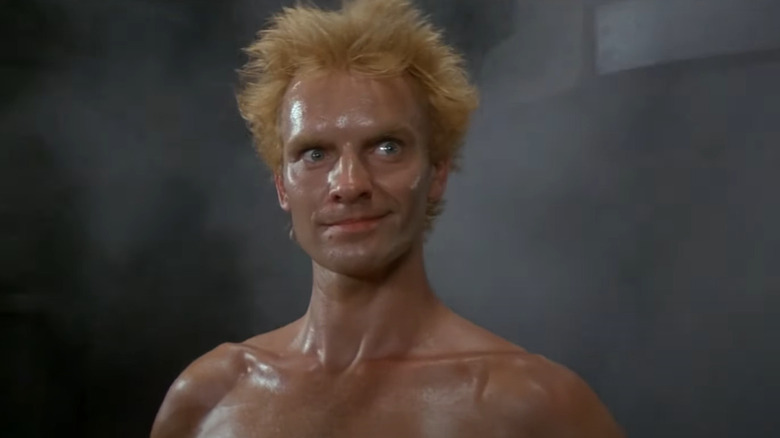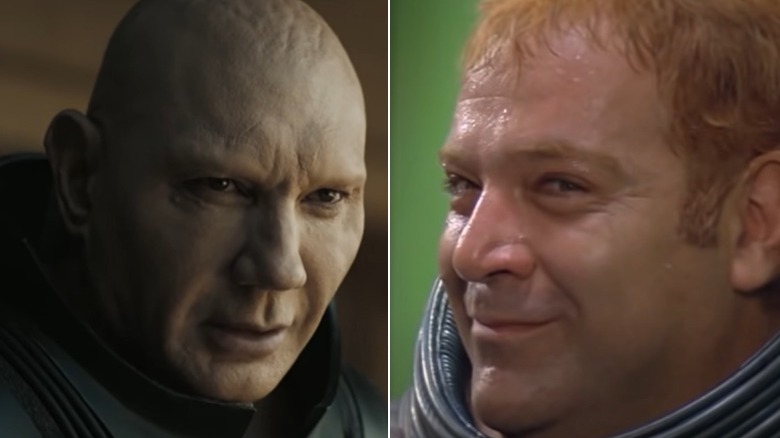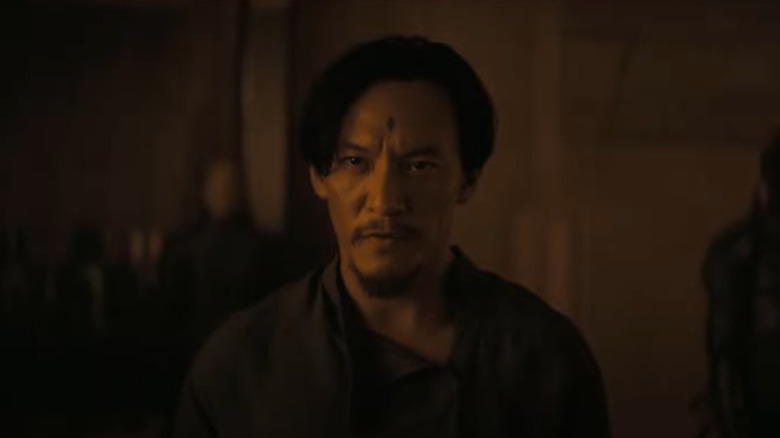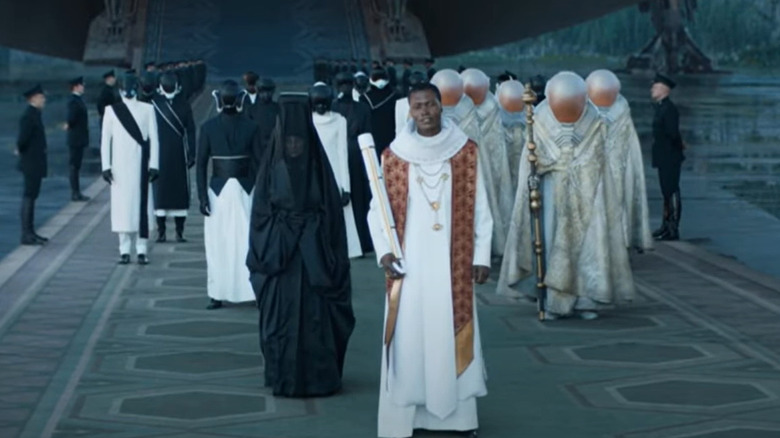Major Details The Dune Movies Get Wrong From The Book
As of February 2022, the 2021 adaptation of the first half of beloved sci-fi novel "Dune" had made over $400 million at the worldwide box office. This is not only impressive because the film was released in the middle of an ongoing global pandemic, but also because audience responses to the first adaptation of "Dune" in 1984 were fairly underwhelming. For comparison, 1984's "Dune" — directed by auteur surrealist David Lynch — made only $31 million against a $40 million budget (via Box Office Mojo).
Today, "Dune" '84 is largely considered a cult classic. The latest iteration — directed by Denis Villeneuve — found Shai-Hulud-sized success with audiences and has a sequel on the way. Viewers clearly love author Frank Herbert's sci-fi epic. However, both adaptations have done a bit of picking and choosing about what they keep from the source material. So in an effort to keep a Mentat-like record of differences between the written word and what appears on screen, here are major details the "Dune" movies get wrong from the book.
Change of voice
In the novel, Frank Herbert frames the story with narration from Princess Irulan. While Herbert's prose jumps between the story's main players, notes from Irulan's diegetic writing serve as the glue holding the ambitious plot together. Epigraphs from Irulan's later works of history give color to each chapter. Irulan's interest in keeping histories is even noted in the novel when Chani Kynes — played by Zendaya in the latest version — mentions Irulan's "literary nature" as the two women meet at the end of the novel. These stylistic flourishes give the narrative of "Dune" the flavor of an official account taken from within its own universe.
While both the 1984 and 2021 adaptations include narration, they both feature different narrators. In the 1984 film, Princess Irulan, played by Virginia Madsen, introduces the universe of "Dune" and quickly explains the importance of spice before the opening title. In the 2021 version, a voiceover from Chani opens the movie and introduces the struggle of the Fremen people to the audience. Her narration is represented as part of the ongoing dreams consuming Paul Atredies.
In each film version, narration gets the audience up to speed on the conflict over melange — aka spice — that is driving "Dune's" universe. While neither film's narrations serve the same purpose as Irulan's in the novel, both versions do attempt to give an entry point to the enormous world the audience enters.
A very different doctor
In the 2021 adaptation, Dr. Liet Kynes — Arrakis' resident ecologist and imperial "Judge of the Change" — is different from her literary counterpart. For starters, Kynes is gender-swapped in the film. In the movie she is played by Sharon Duncan-Brewster, who brings one of the film's best performances. While Herbert's Kynes is written as a man, Duncan-Brewster brings the character's suspicious and intelligent energy off the page and onto the big screen. Even though her character traits remain similar, the end of her plotline is significantly different.
In the novel, Kynes succumbs to the Arrakean desert's elements after the Harkonnens maroon him in the sea of sand to die. The Harkonnens turn on Kynes after discovering the ecologist helped Paul Atreides and his mother survive the Harkonnen and Sardaukar attack. In the film, Kynes helps the Atreides and dies at the hands of Harkonnen soldiers. As she lays dying, one of the planet's great sandworms arrives to turn the Sardaukar soldiers into a snack. It's dramatic, bold, and a big part of why fans love sci-fi films. Kynes' 2021 death scene also teases the "wormriding" ritual which will surely appear in the next movie.
More warrior than poet
Gurney Halleck — War Master of the House Atreides — appears in both the 1984 and the 2021 adaptations. While both films represent the character's loyalty and military might, neither quite nails the character's warrior poet traits. In the novel, Halleck is often reciting poetry, singing, or playing an instrument called the baliset. In both films, directors Lynch and Villeneuve seem to stress his character's warrior side more than they stress his poetic aspect.
The 1984 version, with Sir Patrick Stewart starring as Halleck, does use Stewart's natural — and amazing — theatrical talent to smooth out Halleck's hardened edges. He also plays the baliset in the movie. In the 2021 adaptation, Josh Brolin plays Halleck as all business. If Jason Momoa's Duncan Idaho is played as Paul's cool uncle, Brolin's Halleck is definitely the strict one. Halleck's firmer characterization may be the result of a scene Villeneuve left on the cutting room floor.
In a roundtable with reporters, Villeneuve confirmed he had filmed a scene of Halleck singing and playing the baliset, He went on to say that even though it was "painful to him," he "wasn't able to put it in 'Part One'" (via IGN). Here's hoping the scene appears in "Dune: Part Two" and that Gurney reappears with some poetic wisdom for Paul. Plus, poetry recited by the man who played Thanos sounds like an excellent meme in the making.
The secret garden
"Dune" is an enormous novel — it runs over 500 pages not counting its multiple appendices — so some of its smaller scenes were likely cut to streamline the plot. For example, a scene in the Arrakean palace's greenhouse does not appear in either film adaptation. While the scene is not integral to the greater machinations of the story, it does contain interesting world building.
In the novel, Paul's mom, the powerful Bene Gesserit witch Lady Jessica, explores her new residence. She happens upon a door sealed by a palm lock and decides to investigate. After opening the door, she discovers it hides a greenhouse. Within the greenhouse Jessica discovers a note of warning from another Bene Gesserit witch.
While none of this sounds pivotal to the plot, it quickly gives the audience some insight into Arrakis and the Gesserit order. For starters, the greenhouse is the first sign the environment on Arrakis can be manipulated — a key point of Duke Leto's plan for success. Also, the scene shows readers that the Gesserit look out for one another regardless of their house affiliations. The warning Jessica receives is from a Bene Gesserit married to a Harkonnen, suggesting the order is more important than any family. These details may appear trivial, but they're perfect examples of the ways Herbert informs readers about the inner workings of his fantastic universe. While both adaptations relay similar information to the audience, they don't match Herbert's ability to slowly engross his readers in the enormous world of "Dune."
Bodies by Lynch
Not many people make movies quite like David Lynch. He blends elements of horror, non-linear storytelling, and surrealism into most everything he does and the finished product is always some sort of a beautiful nightmare. So even though Lynch has disavowed his own film of "Dune" many times due to the meddling of studio executives — see this video interview as an example — his fingerprints are still all over the released cut. For an example of Lynch's one-of-a-kind influence on his "Dune" adaptation, fans need to look no further than the "heart plugs" worn by the Harkonnens' servants.
From their initial appearance, Lynch wastes no time ensuring that the audience is immediately repelled by the Harkonnen brood. The Baron's face is riddled with boils and Rabban is drinking the juice of a freshly squeezed insect. Just when viewers think the Harkonnen boys can't get any grosser, the Baron calls a servant into the room. Noticeably the servant appears to have a small brass key surgically implanted into his chest. After accosting the boy, the Baron removes the key, blood comes pouring out, and the servant dies. In true Lynch fashion, the heart plugs are never explained or even mentioned. However, the visceral nature of the device is so grotesque that to behold it tells the audience everything they need to know about the Harkonnens. Only a mad genius like Lynch could devise something that makes these villains even more vile than Frank Herbert ever did.
A made-up meeting
Sometimes directors adapting existing intellectual property like "Dune" add their own scenes to introduce key plot points to the audience faster. David Lynch opens his "Dune" with a meeting between the Emperor of the known universe — Padishah Emperor Shaddam Corrino IV — and a Spacing Guild Navigator. This scene does not appear in the novel.
In the novel, the Emperor does not show up in person — although he is spoken of often — until the back half of the book. On the other hand, the almost mythical Spacing Guild Navigators — pilots who are physically mutated by their high usage of the spice melange — don't appear until 1969's sequel novel, "Dune Messiah." In the 1984 adaptation their meeting is used to kick off the plot.
While the scene removes most of the mystery surrounding powerful characters like the Navigators and the Emperor, it also does some hefty world building in only a few minutes. It quickly establishes Lynch's vision for a "Dune" universe that looks like combination of sci-fi pulp covers and abstract painting. It also details the Emperor's plan to decimate the House Atreides by putting them in direct opposition to House Harkonnen. Laying out this conflict gives any unfamiliar viewers a starting point in the story's labyrinthian plot. Even though the scene's essentially an exposition dump, Lynch's bizarro creature and set design make a dialogue-heavy scene a grotesque treat to watch.
Idaho's Alamo
Jason Momoa's Duncan Idaho — Sword Master of House Atreides — nearly walks away with every scene he's in. Momoa's chemistry with Paul, physicality during fight sequences, and moments of levity bring a ton of energy to Denis Villeneuve's film. Idaho is a fan favorite. So when he dies at the hands of Sardaukar warriors, it's no surprise that it's an emotional highlight and a standout action setpiece all at once.
In the novel, however, Idaho's death occurs during a chapter following Paul's perspective, so Paul and the audience don't get to see Idaho's last stand against the Sardaukar. The film also raises the emotional stakes of Idaho's death by having Idaho close the door between the Atreides and the Sardaukar. Paul seals the door himself in the book.
Small changes like these are what give Idaho's death its wallop on the big screen. Villeneuve spends a sizable portion of the first act developing the relationship between Duncan and Paul. Because the relationship is better developed on screen, the audience feels the impact the decision has on Paul when Duncan sacrifices himself to save the young Duke. It acts as catalyst for Paul's motives in the third act of the film. After losing all of his father figures, Paul must prepare to take responsibility for his survival, the future of House Atreides, and eventually a battle with the Harkonnens.
Mentats wanted
The 2021 version of "Dune" does a lot of work to put the first Atreides family — Duke Leto, his son Paul, and Paul's mother Jessica — at the center of the story. This helps audiences empathize with the good and noble Atreides and despise the despicable and grotesque Harkonnens. However, focusing on the family members also means giving less attention to some of the family's key advisors, like the Mentats.
In the novel, Mentats for House Atreides and House Harkonnen advise the leaders of both houses and figure more prominently in the plot. Mentats are essential because their continued consumption of sapho juice turns their brains into supercomputers. They're responsible for all things involving strategy, probability, and logistics.
While the Mentats for both warring factions are included in the film — Thufir Hawat, played by Stephen McKinley Henderson, and Piter De Vries, played by David Dastmalchian — neither receives much screen time. In fact, the characters are never even called Mentats on screen. In an interview with the Los Angeles Times, Villeneuve explained that cutting down on characters like the Mentats was a deliberate choice to ground the first movie in "Paul's experience." He also said that he hopes to develop other characters who were "left aside a bit" in the sequel. It would be a shame to waste an actor as talented as Henderson in a bit part. Hopefully, fans get more of him in "Dune: Part 2."
Left out rituals
The Fremen — the indigenous people of Arrakis — have many interesting traditions yet to be explored in the latest adaptation. This is probably because the film ends just as Paul is joining the ranks of the Fremen and it is likely more of their customs will be explored in "Part 2." Before the film's end, however, it passes on a chance to depict a water preservation ceremony.
Like the film adaptation, the novel sees Paul duel with Jamis. However, after Jamis' death in the novel, Herbert dedicates all of Chapter 34 to presenting a Fremen funeral and its implications for Paul. Fremen funerals, or water preservation ceremonies, are all about water. During the ritual Jamis' water is distilled into a "bulging sack," weighed, and reclaimed as "the tribe's water."
While a human being entirely drained of fluids is a disturbing idea to outsiders like Paul and Jessica at first, the scene serves to show them and the audience just how important water is to the Fremen. It's an ingenious way to present arguments for ecology and introduce alien customs. While the latest adaptation of the water preservation ceremony may not appear until "Dune Part 2," any curious viewers can check out Lynch's take on the ceremony. Lynch's Fremen funeral was cut from the 1984 theatrical version, but serves as an interesting interpretation of the custom.
Too old to play young
Both the 1984 and 2021 "Dune" adaptations cast actors who were older than their counterparts in the novel. In the book, characters like Paul, Feyd Rautha of House Harkonnen (more on him later), and Chani Kynes are all part of the up-and-coming generation behind current leaders like Lady Jessica and Baron Vladimir Harkonnen, making the story a coming-of-age tale. The age gap also raises the dramatic stakes by constantly pitting Paul and his allies against mostly older and more experienced villains.
Paul is 15 years old at the beginning of the novel. Interestingly enough, the actors playing Paul in both films — Kyle MacLachlan in 1984 and Timothee Chalamet in 2021 — were in their mid-20s when their versions were released. The same goes for its female leads. Chani has been portrayed twice on the big screen by women in their mid-20s, Sean Young of "Blade Runner" fame in 1984 and Zendaya in the latest adaptation. While older actors often play teens (Zendaya's currently playing a high schooler on HBO's "Euphoria"), the age difference is more noticeable in Lynch's version.
MacLachlan and Young simply don't pass as teenagers. While the pairs' performances fit well into Lynch's absolutely gonzo sci-fi vision, their apparent age makes the story seem centered around the adults. In the 2021 version, the leads look young enough to be older teens, so the coming-of-age story present in the novel remains in the more recent film.
Putting the swords down
One of the most compelling features of "Dune" is its preoccupation with hand-to-hand combat. By envisioning a world where most combatants rock a projectile-proof body shield, Frank Herbert created a necessity for blades. While the latest adaptation contains several scenes showing the importance of sword and knife fighting in the "Dune" universe, David Lynch's version goes a different route.
Lynch's version included a weapon called a "weirding module." The weirding module — a weapon which essentially turns sound into a weaponized laser beam — doesn't appear in Herbert's novel. The weapon serves as a stand-in for the martial arts and powers practiced by the witches of the Bene Gesserit known as the "weirding way." Lynch turns the "weirding way" into a means to deal out physical damage with one's voice.
In other words, the 1984 version replaces the Bene Gesserit's unique combat abilities with voice-activated ray guns. This change ends up de-emphasizing the importance of hand-to-hand combat in the movie. The attention to blade combat is a huge part of what makes the book's vision of the far future so fascinating and different from other sci-fi worlds. Luckily for fans, the 2021 adaptation did away with the weirding modules and delivered some truly epic sword fights.
Where's Feyd?
In the book, Paul's nemesis, Feyd Rautha, appears the first time readers encounter the Harkonnens. While Rautha is present throughout Lynch's version — he's played by The Police frontman Sting in the 1984 film — he is entirely absent from Villeneuve's adaptation. Rautha is an awesome villain because he acts as a twisted reflection of Paul.
Like Paul, Rautha is a skilled warrior, extremely intelligent, and the heir apparent to a powerful family. Unlike Paul, Rautha is also one sick puppy. In the book, he spars to the death with Harkonnen slaves for fun. He was also raised by the most cunning, ruthless, and power-hungry uncle to ever wear anti-gravity pads: Baron Vladimir Harkonnen. While Paul struggles to wield his new power for all things good, Rautha can't wait to seize power to do all things bad.
While some fans might have been disappointed with Rautha's absence in the latest adaptation, they can rest assured he'll appear in the sequel. As of March 2022, movie trades like Variety reported that Austin Butler, recently seen as Tex in Quentin Tarantino's "Once Upon a Time in Hollywood," is being eyed for the role. Even though his screen time is fairly limited in "Hollywood," Butler leaves a lasting impression as an evil member of the Manson family. Plus anyone hoping a rock star would step into the role of Feyd Rautha like Sting did in 1984 may be happy to hear that Butler will play Elvis Presley in the upcoming biopic "Elvis."
The tale of two Rabbans
The Harkonnen court is significantly slimmed down in the 2021 adaptation of "Dune." The only named Harknonnen characters the audience encounters are the Baron, the Baron's Mentat, and the Baron's least favorite nephew, Glossu Rabban. In the 1984 version all the major Harkonnen players are present throughout the film. In the 2021 version, Rabban, aka "The Beast" — a moniker he earned for killing his father — is played by Dave Bautista. In 1984, "The Beast” was portrayed by Paul L. Smith. However, while he appears early in both film adaptations, he doesn't appear in the book until around the halfway mark.
In the novel and the movie, Glossu Rabban is called upon by his maniacal uncle to "squeeze" the spice out of Arrakis and slaughter the Fremen after the Harkonnens retake the planet. Unlike both movie adaptations however, Rabban isn't introduced on the page until after the Baron reclaims Arrakis. When he is introduced, the reader is made immediately aware of the Baron's true feelings about his nephew. In what's maybe the greatest burn in "Dune," the Baron describes his nephew as a "muscle-minded tank brain." The Baron plans to use Rabban to work Arrakis and its people so brutally that by the time his favorite nephew, Feyd Rautha, comes of age, the people of Arrakis will be grateful for new leadership. Hopefully this plan makes it to the screen in "Dune Part 2."
A deeper plot
Fans of the novel will likely notice the Baron's full plot to undermine House Atreides is streamlined in both the 2021 and 1984 adaptations of "Dune." The book goes into a lot of detail about the Baron's full scheme to reclaim Arrakis. In fact, Herbert dedicates an entire chapter to the Baron outlining the details of the scheme to Feyd and Piter. The linchpin of the Baron's plan is Dr. Yueh.
Wellington Yueh is the trusted in-house physician of House Atreides. The Baron has Dr. Yueh's wife, Wanna, abducted to gain leverage over the doctor. However, the Baron also plans to sow discord in the Atreides camp by pitting the Atreides Mentat against Duke Leto Atreides' wife, Jessica. The idea is that Atreides' human computer and resident witch will be too busy snooping on each other to pick up Dr. Yueh's scent.
While it's hard to know exactly why some plot threads are cut and others are kept during adaptations, both film versions streamlined the Baron's plot to solely focus on the Yueh of it all. This isn't necessarily a bad thing, as Dr. Yueh's storyline is both compelling and tragic. However, simplifying the Baron's plan paints the Baron to be a bit more ruthless than he is cunning. He's still terrifying to behold in any version, but he definitely reads a bit smarter on the page.
Galactic economics 101
"Dune" is a best selling sci-fi novel for many reasons, but its deep lore is definitely a strong selling point for fans. One aspect of the novel's lore that hasn't made it to the big screen in its entirety is the universe's detailed economic system. The "Dune" universe is ruled by the Padishah Emperor and governed by the council of Great Houses called the Landsraad. All of these houses, including the imperial house, participate in the open market of trading goods and services across the galaxy. Because the "Dune" universe is ruled by money — much like our own — real political power comes from a given house's stake in the Combine Honnete Over Advancer Mercantiles, or the CHOAM Company. Think the East India Trading Company but on a galactic level.
Essentially, any house with a bigger piece of CHOAM's pie than the Emperor can shirk his rule and do whatever they want. The contest for economic supremacy drives the plot as much as any other of its essential elements. While it's definitely a complex system, it gives Herbert's universe a level of specific detail a lot of other sci-fi properties lack. Like the realpolitik in "Game of Thrones," the economic systems of "Dune" create relatable motivations for characters in particularly unrelatable situations. Both film adaptations have simplified the complexities of interstellar economics, but maybe "Dune: Part 2" will introduce the CHOAM Company — to the delight of dedicated fans everywhere.
